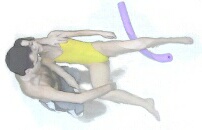My gaze drifts from the cozy, sheltered, warm-water pool where we study, to the palm trees outside that are gently cradled by the wind. Just beyond is the vastness of the ocean, quietly rippling and constantly changing colors. Palm trees drip gold & diamonds into this ocean of emerald mirror. Another day in paradise! I am full of gratitude that I can study the Jahara® Technique at Minakshi’s Island Studio in the Florida Keys. What a joy and privilege it is, to continue to learn new forms of water work in such an environment, with wonderful friends. The first week has been a repetition for me, Jahara® Basics. Minakshi has been teaching this class in her uniquely patient and precise way. What is it all about, this Jahara® Basics class? Two things seem particularly worthwhile to mention in comparing this work with Watsu® and WaterDance®. In Jahara® more attention is given to body mechanics and the physical properties of water. A very important tool for transmitting this understanding is Jahara's Aquatic Footwork™, which is necessary to practice. For instance, "1-2-3-4 step, step, pivot"... How many times have I heard this during the last few days? Until it feels as though it has become a part of my flesh & blood. My own posture blossoms with the way that my body unfolds and turns with the steps. It is surprising how different this posture is from the large, spread-legged posture of Watsu®. There is a great elegance and grace visible when a Jahara® Specialist is aware of the full length of the spine and when movement is an expansion from the coccyx up to the atlas. There are a number of principles that differentiate Jahara® from other forms of aquatic bodywork. One is that the client’s head is always leading, never the feet. In the beginning this appears to Watsu® and WaterDance® practitioners as unusual. This is one of many patterns that we will be dissolving. By practicing "head-lead", we allow the spine of the client to constantly receive a gentle traction against the resistance of the water. Mario Jahara explains that the movement is organic and natural, because in nature, animals generally move head first. Another principle of Jahara® is its slowness. Every inch of the movement is performed precisely and clearly. The intention of the giver to move in an optimal body posture helps the receivers to open and dissolve their own contracted patterns. Mario explains that these body-friendly ideas are not at all new nor invented by him. They build on well-known forms, for example the Alexander Technique from Frederick Mathias Alexander. In the beginning the concentration required for this disciplined study means practice, practice, practice. But with time I sense the quality of my work in the water starting to change and become even more effortless. My body structure opens up and suddenly endless space unfolds inside. This personal experience reflects the generous movements of the Jahara® Technique. Practicing becomes more and more joyous, sensuous, pleasurable. In addition, my own understanding has a profound effect on the receiver. Deep silence, physical opening, expansion and a healthy muscle tone are received with gratitude. The next course, Jahara® Expansion, is a natural development of the first week. Mario Jahara teaches this course in a very gentle and caring way. As a participant I can feel that Mario puts his heart and his life philosophy into this form of what he calls "aquatic body integration". He often reminds us that true strength and real power ultimately lay in the power of gentleness. While watching Mario talking, moving, and working, I observe how he treats himself and his students, and it comes to mind that he lives these principles as well as teaches them. In this Expanded class we learn to adapt the principles of the Jahara® Technique to the different body-types of clients. Instead of studying specific sequences, as in Watsu® and WaterDance®, we learn right from the beginning to be creative with an endless variety of possibilities. Mario emphasizes that it is not about learning as many new moves as possible, instead he prefers that we understand the principles that underlie this work. In this way, we may build on these principles to express our own creativity. In the third course, Jahara® Underwater, we focus on further flowing movements, under as well as above the water. A curiosity for me, as a WaterDancer is that Mario is working without a nose clip. Instead, he closes the nose with thumb and index finger. This technique requires a lot of sensitivity and expert skills. Without a doubt, there is an advantage to this method. As a receiver I am not forced to breathe through my mouth, I am able to breathe through my nose, as I am accustomed to. As a result, I am not even aware whether I am above or below the water surface. Well, even in paradise three weeks can become long—especially considering that we have studied new material daily, every morning and afternoon. This makes it easier to understand, that we probably all sometimes had a weak moment, when we stared with a blank look at the poolside notes and wondered: "Was I actually here for the past three weeks?" Then it is very soothing to remember some of Mario’s words: "Be gentle, relax, open up and give your own creativity a chance." Published in the Swiss newsletter “Unsere Welle”; August 2002. Arjana co-founded WaterDance® and is the director of IAKA-Switzerland, Institut für Aquatische Körperarbeit®. |